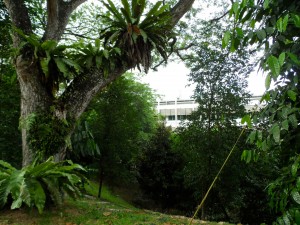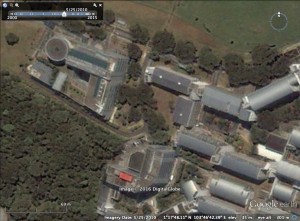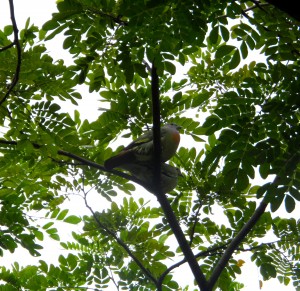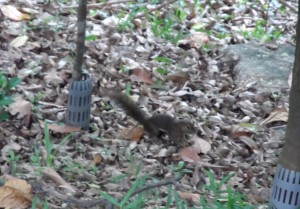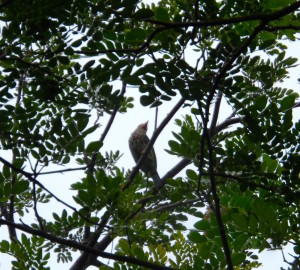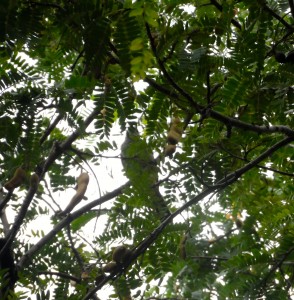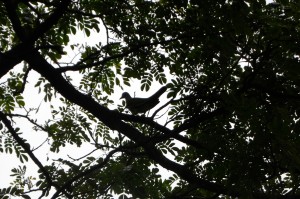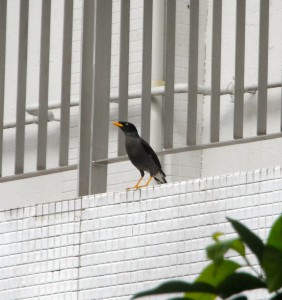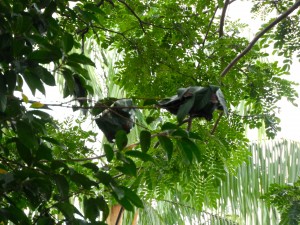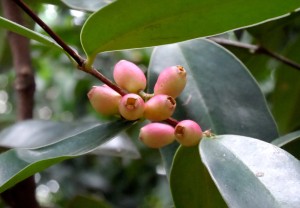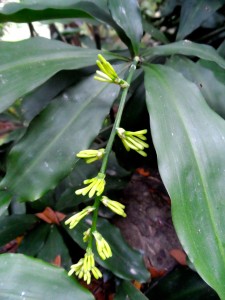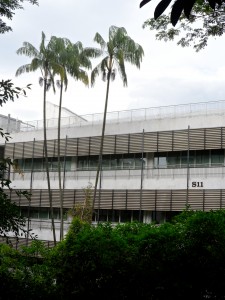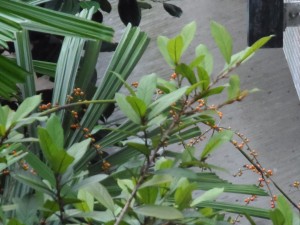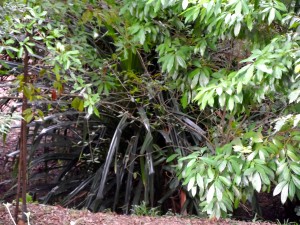Back in those days when I was in Year 1/ 2, most of my lectures started at 10 a.m. and were held at LT32. Once in a while my friend would be late for class and so at 10.05 a.m., I would text her to ask her where she is and she would reply, “climbing the LT32 mountain!!” Ten minutes into the lecture, she would appear at the door then make her way towards her seat next to me, panting. To most of us who have had lessons at LT32, it is probably intuitive to us that my friend’s “LT32 mountain” refers to the laborious “hike” up the slope along Science Drive 4, and then up again the long flight of stairs that would eventually lead us to the carpark behind LT32.
For the past coming to 4 years in NUS, I’ve “hiked” that path umpteen times. Along the way, once in a while I would slow down just to spend a couple more minutes enjoying the vegetation on the left of the walkway, i.e., this:
To most of us who started started studying in NUS only 3 to 4 years ago, perhaps this patch of vegetation seems just like any other “garden” or “park” in the middle of a built-up area. Me too, until a year ago when I learnt from my then UROPS (and current FYP) supervisor how this space was greened up.
Unfortunately, I was unsuccessful in sourcing for photos of the area before it was greened up, but here’s how it looked like on Google Earth:
We can see that it was still a very bare area with hardly any green cover six years ago in 2010 (the triangular patch in the middle of the photo). But today, the same patch is thriving and growing so well with NATIVE SPECIES. Yes, species that are native to Singapore. Theoretically speaking, planting native flora may support greater local wildlife. I wanted to experience for myself how this patch of native green cover has attracted native wildlife in our NUS campus and so I spent a short one hour at the area. To my pleasant surprise, my eyes were treated to a feast! Here are some of the fauna and flora I found:
This gentle dove was happily feeding on the ground before it flew to this concrete ledge, seemingly aware I was snapping photos of it.
These two love birds were comfortably roosting high up in the tree canopy. The male pigeon (left) looks much more colourful with pink nape and neck, and orange covering the lower breast area, while the female (right) is largely covered in a green coat.
The playful squirrel was foraging for food for a good 10 to 15 minutes, running up and down the treelets and across the ground, and I managed to snap this shot (still slightly blur though) after several failed attempts.
I’m not sure what species this is, but it could be a lineated barbet (usavifauna.wordpress.com/2012/07/29/lineated-barbet/). I’m just guessing though.
The call of a Collared Kingfisher (Todiramphus chloris) (it’s a bit soft, please try to increase the volume level of your computer!)
In particular, insects are an interesting one because they form the lower tropic levels and may underpin food webs, thus supporting more charismatic species at higher trophic interactions. But the most important of all is of course the plants, which is the basis on which all life is based. Just to share some of the beautiful flora that can be found in this patch of native green area!
Sometimes when this plant (Suregada multiflora) is producing lots of flowers, it’ll be easy to pick up a very slight fragrance that whiffs past when the wind blows. This is a critically endangered species and one whole row of it is planted just next to the brick walkway.
These three palms are probably the most conspicuous plants as they are “sticking out” of the entire patch. In fact, several species of back mangroves/ mangrove associates/ swamp-adapted species were planted at the bottom of the slope because of the more water-logged conditions below. These include:
I’m not 100% certain of this species ID, but it does seem like it, from the bright orange fruits!
My conclusion at the end of my mini field trip was that there is so much biodiversity in the area! This is a good example to illustrate how urban biodiversity can be enhanced by providing (or planting) species’ habitats. Plus, an added bonus is that most of the plants in the area are native, some of which are locally threatened, e.g., the Nibung palm and False Lime, and thus this helps in the conservation of local species as well. While urbanisation has inevitably led to the loss of natural habitats and human-wildlife conflicts, I guess we can still make the best out of a not-so-good thing (e.g., by creating artificial habitats for organisms and still try to attract fauna into our urbanised areas). I will illustrate this using the following two examples:

Wild Pepper seedlings growing below larger shrubs and trees. Where space is a constraint, plants can be cultivated at different layers so as to increase the number of plants per unit area!
Who would have known? Everyday we walk in and out of our campus not knowing that all these beautiful flora and fauna exist just right at our doorstep! Of course, as an amateur, I’ve probably only scratched the surface of the much more diverse and rich urban biodiversity we have in NUS, as well as the rest of Singapore, but this only goes to show that while we can’t “un-urbanise” an area, or “un-plant” exotic species, or undo the damages already done, we still can work around the situation and make the best out of it!
(all photographs were taken by me)
